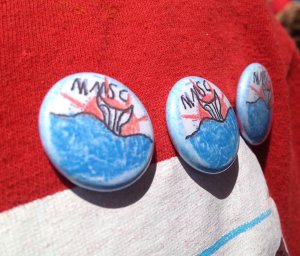Learning Collaboration: Marine Mammals and Groovy Buttons
Endgrain Coffee Bar is the newest small business in town, with creations to satisfy the craftiest of coffee connoisseurs. And like all new small businesses in my town, I was stoked to show my support. Plus, the end of the school year requires mucho caffeine to take on 23 eight-year-olds with visions of summer. While I waited for the caffeine to settle, I noticed a tiny circular button showcasing Endgrain’s logo. I love a good button just as much as a good coffee, so I inquired about buying one.
The owner of Endgrain knows a teacher at The Y.A.L.E School--a school in New Jersey for kids with disabilities. He teaches kids life/job skills and one of the skills is the production of buttons.
As he was telling this story, I automatically started thinking of how my students could collaborate with the Y.A.L.E students. By the end of the transaction, and almost by the time my coffee was consumed, I had it all planned out.
Jump Start
We already had a purpose for the buttons. My class was researching marine mammals and sea turtles for our service-learning project/benefit walk for the Marine Mammal Stranding Center in Brigantine, NJ. The MMSC is a non-profit organization that rescues and rehabs marine mammals and sea turtles along the jersey shore. Our goal was to research marine mammals and sea turtles and also study the MMSC’s mission statement. We then sought out donations for the center and pledged to walk/jog for one hour around the school grounds.
The buttons were a perfect way to get crafty, promote awareness, and also thank donors. My plan was to have my kids draft up the designs and then team up with the Y.A.L.E. students for production.
The Buttons
Math: We started with using compasses to learn how to measure diameter.
Design: The buttons were very small, so we experimented with tiny basic designs that would help promote the walk. Students went through many drafts before they added color and outlines.
Marketing/Promotion: We discussed why buttons are an easy and relatively inexpensive way to promote a product by wearing the button or giving them away.
Government: I tied in the button-making project with our government unit and we looked out how politicians use buttons in campaigns and also how to write slogans/mottos.
Collaboration: YES!! This was the best part. We designed a product, and then James Gross (Y.A.L.E school teacher and button making manager), sent my class pictures of his students turning our art and ideas into products. This was super groovy.

The MMSC sent two interns to my school during the walk to share marine mammal/sea turtle artifacts and cheer on the walkers. The center is relatively local (about 40 minutes) so the use of the donations can be seen with a short ride to the beach. A visit to the center makes for a great summer day trip.
The collaboration between schools was a meaningful and deep learning experience. The purchase of t-shirts, buttons or banners for an event is usually just a click away. The kids never get to see the production of a product. In this instance, my students saw their designs come to life.
I know it’s the end of the school year, but keep your eyes open for buttons. They just might change the course of your class.
For more pictures, check out my school website: www.onkidwriting.com
Marine Mammal Stranding Center: www.mmsc.org
This piece was originally submitted to our community forums by a reader. Due to audience interest, we’ve preserved it. The opinions expressed here are the writer’s own.